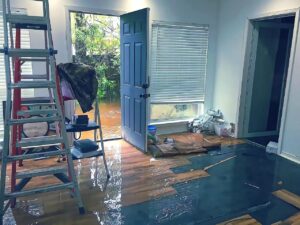Water damage comes in many forms. Often, we only think about the water damage that we don’t see coming, like floods. However, plenty of other types of water damage can be prevented, or at least minimized, with a little work and pre-planning.
In this article, we discuss some practical tips that homeowners can use to prevent or lessen different types of water damage, including floods, roof damage, or leaking pipes.
5 Tips to Protect Your Home from Water Damage
Water damage is one of the most common and expensive disasters your home can experience, costing billions of dollars yearly. Protect your most important asset against water damage with the following tips.
1. Insulate Pipes
Cold temperatures can cause water pipes to freeze, building up pressure within them. Due to this pressure, the pipe can rupture and possibly result in serious flooding, particularly when there is no one around to turn off the water or when the burst pipe goes unnoticed inside a wall or under a floor.
The best way to protect pipes from freezing is to keep them warm enough to stay above the freezing point. You can do so by insulating your home’s exposed pipes, especially in the basement or attic.
You can fit pipes with fiberglass sleeves, or with foam or rubber to help reduce the chances of freezing. With the right insulation, a pipe stays closer to the temperature of the water inside it.
2. Prevent Water Seepage in the Basement
Water often seeps into basements after heavy rain because of cracks in the walls or the foundation. This is of particular concern in older homes, or in those that experience freezing temperatures each winter that can lead to cracks and damage to the concrete foundation of the home. To prevent your basement from water damage, consider resealing any cracks that appear in your home’s foundation.
You can also install a backwater valve to protect your basement from sewer backup. Although most basement water problems aren’t caused by sewer backups, the number of backed-up sewers is growing at an alarming yearly rate of about 3%.
A backwater valve is designed to let water flow in one direction only — out of your home. An unexpected heavy downpour can overwhelm the municipal sewer lines, causing sewage to flow back towards your house. By installing a backwater valve, you can prevent sewage from flowing back into your home and causing damage.
3. Fix Roof Damage Quickly
Another common way that water gets into homes is through the roof. Regularly check your roof for misplaced, broken, and aging shingles and replace them quickly to avoid any damage. Even a single missing shingle or small amount of damage could allow water from rain to get inside.
You may also want to inspect your downspouts and remove debris that may have accumulated in rain gutters. When water backs up into your gutters, it can cause damage to your roof and the exterior of your home, and possibly let water get into your walls. Place downspouts in such a way so that water is directed away from the home. Consider installing gutter guards to avoid clogging. This will stop water from accumulating on the roof and keep it flowing away from the home.
4. Turn off Outdoor Faucets in the Winter
Usually, external faucets have shut-off valves located inside your home. Often, problems are caused by residual water in the pipe that leads up to this valve. When freezing temperatures occur, water expands, and if it has nowhere to go, it will damage whatever is constraining it; in this case, the pipe.
Therefore, it’s vital to shut off the valve during the winter. After shutting off the supply, open the faucet to let the air flow in and water drain out. This air supply will help ensure that any water remaining in the faucet has room for expansion.
5. Inspect Your Indoor Plumbing Systems
Periodically check all hoses leading to indoor appliances such as dishwashers, water heaters, and washing machines. You may also install a water leakage monitoring and shut-off system that notifies you of any seepage problems. If you see hoses that have cracks or leaks, replace them right away.
Also, inspect the seal and caulking around tubs and showers to ensure they are sealed properly. If you are traveling, turn off the water supply to your appliances and never leave the house while the dishwasher or washing machine is running. If one of these machines begins to leak, the sooner you shut it off, the less damage your home will suffer.
It’s important to know where the main water shut-off valve is located in your house. A broken hose or a burst pipe can send water rushing into your home. It will save stress, money, and time if you are able to quickly locate and cut out the main water supply when something goes wrong.
Reverse and Repair Water Damage with Emrick Services
While these tips are going to protect your home from potential water damage, it’s important to have flood insurance and a good water damage restoration company like Emrick on hand in case disaster does strike.
In the event of water damage, call your insurance company and request to work with Emrick. We are experts in handling even the largest and most complex water damage restoration projects.
We comprehensively document all damaged contents within a water-damaged structure, making insurance claim filing as effortless as possible. We will work directly with your insurance company to streamline the claim. You can focus on making decisions and recovering what is still salvageable instead of handling extensive paperwork.








